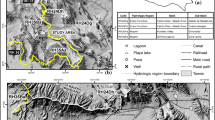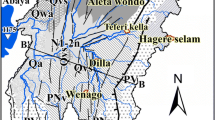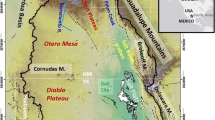Abstract
The Barwon Downs Graben lies on the northern flanks of the Otway Ranges and is situated approximately 70 km southwest of Geelong, Victoria, Australia. The major lower Tertiary Barwon Downs Graben aquifer comprises highly permeable sands and gravels interbedded with clays and silts of the hydraulically interconnected Pebble Point, Dilwyn and Mepunga Formations. Groundwater flows east into the Barwon Downs Graben from the Barongarook High, and yields 14C ages up to ∼20 ka implying that recharge rates are low and, consequently, that the resource could be impacted by overabstraction. The presence of three different lithological units has led to the development of localized flow systems that has resulted in a lack of regular spatial variations in groundwater chemistry. Stable isotopic data suggests that groundwater was recharged under similar climatic conditions as of today. The major ion chemistry of the freshest groundwater is dominated by Na and HCO3 while higher TDS groundwater, from the confining Narrawaturk Marl, is dominated by Na and Cl. Cl/Br ratios are close to rainfall suggesting that halite dissolution is not the principle source of salts. An excess of Na relative to Cl in fresher groundwater suggests that feldspar dissolution has occurred, however, water–rock interaction is limited. The concentrations of Ca, Mg, and SO4 are controlled by silicate dissolution and ion-exchange reactions with clays.
Résumé
Le graben de Barown Downs est situé sur le flanque nord de Otway Ranges, 70 km sud ouest de Geelong, Victoria, Australie. L’aquifère majeur inférieur d’age tertiaire de Barown Downs se compose de sables et de gravières, de grande perméabilité interconnectés avec des horizons d’argile et de limon qui sont en liaison hydraulique avec les formations de Peble Point, de Dilwyn et de Mepunga. La principale direction de l’écoulement des eaux souterraines est vers l’est tendis que le 14C indique une age d’approximativement de 20 ka ce qu’implique une faible recharge. En conséquence la ressource peut être affectée par une surexploitation. Les trois unités différenciées par la lithologie ont conduit aux systèmes d’écoulement locaux avec une variation importante de la composition chimique de l’eau. Les isotopes stables suggèrent que l’aquifère a été alimenté dans des conditions climatiques comparables avec les conditions actuelles. Les ions prédominants dans l’eau sont le Na et HCO3 tendis que l’eau avec des hautes valeurs en résidu sec provenant de marnes de Narrawaturk présente surtout des ions de Na et Cl. Le rapport Cl/Br dans les eaux souterraines et dans les précipitations présente des valeurs comparable en suggérant que la dissolution de l’halite n’est pas la principale source du sel. Un excès de Na par rapport au Cl suggère une dissolution des feldspaths mais que l’interaction avec la marice rocheuse est assez limitée. Les concentrations en Ca, Mg et SO4 sont conditionnées par la dissolution des silicates ainsi que par les échanges ioniques avec les minéraux argileux.
Resumen
El Graben de Barwon Downs yace en los flancos norte de las Montañas Otway y se sitúa aproximadamente 70 km suroeste de Geelong, Victoria, Australia. El mayor acuífero del Terciario Inferior, dentro del Graben Barwon Downs, comprende arenas y gravas muy permeables, interestratificadas con arcillas y limos que están interconectados hidráulicamente con las Formaciones Pebble Point, Dilwyn y Mepunga. El agua subterránea fluye hacia el este dentro del Graben Barwon Downs, proviene del Barongarook High y por 14C dió edades hasta de 20 mil años, que implican que las proporciones de la recarga son bajas y por consiguiente, que el recurso pudiera afectarse por sobre-explotación. La presencia de tres unidades litológicas diferentes ha llevado al desarrollo de sistemas de flujo locales, que han resultado en la carencia de las variaciones espaciales típicas en la química del agua subterránea. Los datos de isotópos estables hacen pensar en que el agua subterránea se recargó bajo condiciones climáticas similares a las de hoy. La química de los iones mayores del agua subterránea más dulce está dominada por el Na y HCO3, mientras que el agua subterránea con los SDT más altos, de la Marga Narrawaturk de tipo confinado, está dominada por Na y Cl. La relación de Cl/Br está cerca de los valores para la lluvia, lo que hace pensar que la disolución de la halita no es la fuente principal de las sales. Un exceso de Na con relación al Cl, en las aguas subterráneas más dulces, sugiere que ha ocurrido la disolución del feldespato, sin embargo, la interacción entre agua-roca es limitada. Las concentraciones de Ca, Mg y SO4 son controladas por la disolución del silicato y por reacciones del intercambio iónico con las arcillas.










Similar content being viewed by others
References
Acworth RI, Jankowski J (1993) Hydrogeochemical zonation of groundwater in the Botany Sands Aquifer, Sydney. Aust Geol Sur Org, J Aust Geol Geophys 14:193–199
Arad A, Evans R (1987) The hydrogeology, hydrochemistry and environmental isotopes of the Campaspe River aquifer system, north-central Victoria, Australia. J Hydrol 95:63–86
Barth SR (2000) Stable isotope geochemistry of sediment-hosted groundwater from a Late Paleozoic – Early Mesozoic section in central Europe. J Hydrol 235:72–87
Bethke CM (1998) The Geochemists Workbench v.3.0. University of Illinois
Blake WJR (1978) Groundwater for Geelong: Completion report on the hydrogeological investigation of the Barwon Downs Basin. Geological Survey of Victoria. Unpublished Report 1978/38
Blake WJR (1980) Geology and the hydrology of the Early Tertiary sediments of the Otway Basin. Unpublished Master of Science thesis. Latrobe University
Brouste L, Marlin C, Dever L (1997) Geochemistry and residence time estimation of groundwater from the upper aquifer of the Chihuahua desert (Comarca Lagunera, northern Mexico). Appl Geochem 12:775–786
Cartwright I, Weaver TR, Fulton S, Nichol C, Reid M, Cheng X (2003) Hydrogeochemical and isotopic constraints on the origins of dryland salinity, Murray Basin, Victoria, Australia. Appl. Geochem. 19:1233–1254
Clarke I, Fritz P (1997) Environmental isotopes in hydrogeology. CRC, New York
Coplen TB (1988) Normalisation of oxygen and hydrogen isotope data. Chem Geol 72:293–297
Davis JC (1973) Statistical and data analysis in geology. Wiley, New York 550p
Davis SN, Whittemore DO, Fabryke-Martin J (1998) Uses of chloride/bromide ratios in studies of potable water. Ground Water 36:338–351
Davis SN, Cecil L, Zreda M, Moysey S (2001) Chlorine-36, bromide, and the origin of spring water. Chem Geol 179:3–16
D’Costa DM (1989) Late Quaternary vegetation and environments from Lake Terang, western Victoria. M.A. Thesis. Monash University, Melbourne (unpublished)
Eaton AD, Clesceri LS, Greenberg AE (1995) Standard methods for the examination of water and waste water, (19th edn). American Public Health Association, Washington, DC
Edmunds Wm, Smedley Pl (2000) Residence time indicators in groundwater; the East Midlands Triassic sandstone aquifer. Appl Geochem 15:737–752
Edmunds Wm, Bath AH, Miles DK (1982) Hydrochemical evolution of the East Midlands Triassic sandstone aquifer, England. Geochem Cosmochim Acta 46:2069–2082
Elliot T, Andrews JN, Edmunds WM (1999) Hydrochemical trends, palaeorecharge and groundwater ages in the fissured Chalk aquifer of the London and Berkshire basins, UK. Appl Geochem 14:333–363
Herczeg AL, Edmunds WM (2000) Inorganic ions as tracers. In: Cook P, Herczeg AL (eds) Environmental tracers in subsurface hydrology. Kluwer Academic, Boston, p 31–77
Herczeg AL, Torgersen T, Chivas AR, Habermehl MA (1991) Geochemistry of ground waters from the Great Artesian Basin, Australia. J Hydrol 126:225–245
Herczeg AL, Simpson HJ, Mazor E (1993) Transport of soluble salts in a large semiarid basin; River Murray, Australia. J Hydrol 144:59–84
Johnston CD (1990) Final report on AWRAC Partnership Research Program Project p 86/20, Development of Design Theory for Artificial Recharge Waters, p 1—99. CSIRO Division of Water Resources, Perth, Australia
Johnston CD (1992) Experimental artificial recharge at Boundary Creek, southeast Victoria. Report of 1988 trials. CSIRO Division of Water Resources, Technical Memorandum 92/10
Kershaw AP (1998) Estimates of regional climatic variation within southeastern mainland Australia since the last glacial maximum from pollen data. Palaeoclimates 3(1–3):107–134
Kimblin RT (1995) The chemistry and origin of groundwater in Triassic sandstone and Quaternary deposits, northwest England and some UK comparisons. J Hydrol 72:293–311
Lakey R, Leonard J (1982) Gellibrand groundwater investigation, Stage 2, Completion report. Geological Survey of Victoria unpublished Report 1982/107. Department of Minerals and Energy
Lakey R, Leonard J (1984) Regional water strategy plan for the southwestern region of Victoria, Stage 1. Submission to Natural Resources and Environment Committee Inquiry in Water Resources Management. Victorian Department of Minerals and Energy
Macumber PG (1991) Interaction between groundwater and surface water systems in northern Victoria. Victoria Department of Conservation and Environment Melbourne, Australia. 345p
Macumber PG (1992) Hydrological processes in the Tyrell Basin, southeastern Australia. Chem Geol 96:1–18
McMahon TA (1992) The valuation of benefits of hydrologic information. Centre for Environmental Applied Hydrology. University of Melbourne, Australia
Parkhurst DL, Appelo CAJ (2003) PHREEQC A computer program for speciation, batch-reaction, one-dimensional transport, and inverse geochemical calculations. United States Geological Survey
Stumm W, Morgan JJ (1981) Aquatic Chemistry. Wiley, New York
Tickell SJ, Cummings JG, Leonard JG, Withers JA (1991) Colac 1:50 000 map sheet: Geological Report. Geological Survey of Victoria. Report No. 89. Department of Manufacturing, Industry and Development, 53p
Vogel JC (1970) Groningen radiocarbon dates IX. Radiocarbon 12:444–471
Weaver TR, Bahr JM (1991) Geochemical evolution in the Cambrian–Ordovician sandstone aquifer, eastern Wisconsin; 2, Correlation between flow paths and groundwater chemistry. Ground Water 29:510–515
Weaver TR, Frape SK, Cherry JA (1995) Recent cross-formational fluid flow and mixing in the shallow Michigan Basin. Geol Soc Am Bull 107:697–707
Witebsky S, Jayatilaka C, Shugg A (1995) Groundwater development options and environmental impacts Barwon Downs Graben, southwestern Victoria
Acknowledgements
The authors wish to thank Barwon Water for availability and access to the observation and pumping bores in the Barwon Downs Graben. Sinclair Knight Mertz is gratefully acknowledged for information and data provided on the region.
Author information
Authors and Affiliations
Corresponding author
Rights and permissions
About this article
Cite this article
Petrides, B., Cartwright, I. The hydrogeology and hydrogeochemistry of the Barwon Downs Graben aquifer, southwestern Victoria, Australia. Hydrogeol J 14, 809–826 (2006). https://doi.org/10.1007/s10040-005-0018-8
Received:
Accepted:
Published:
Issue Date:
DOI: https://doi.org/10.1007/s10040-005-0018-8




